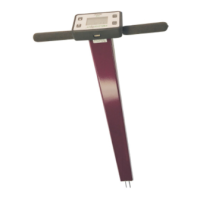17
To improve accuracy, correlate TDR period readings with a soil-
specific sample set.
VWC data can be correlated by measuring the weight of a known
volume of saturated soil as it is gradually dried, by gradually wet-
ting a known volume soil with measured increments of water, or
by using a neutron probe. In most cases, gravimetric sampling is
performed. This procedure is briefly described below.
1. Establish a number of field sites to sample.
2. Wet each site with varying amounts of water.
3. Obtain FieldScout TDR period reading at each sample site.
4. Extract a known volume of soil at each sample site. Ideally, an
undisturbed soil core. Reduce evaporation - store samples in a
sealed plastic container.
5. Weigh the wet soil samples.
6. Dry the samples (105
o
C for 48 hours) and weigh again.
7. Plot sample measurements against FieldScout TDR readings.
Regression analysis is used to develop a formula to correlate TDR
readings to the sample data.
Volumetric water content calculations:
VWC = 100*(M
wet
- M
dry
)/(
w
*V
tot
)
Gravimetric water content calculations:
VWC = GWC *(
b
w
)
GWC = 100*(M
wet
- M
dry
)/M
dry
b
= M
dry
/V
tot
Where:
M
wet,
M
dry
= mass (g) of wet and dry soil respectively
V
tot
= total soil volume (ml)
w
= density of water (1g/ml)
Appendix 1: Soil-Specific
Reading Correlation

